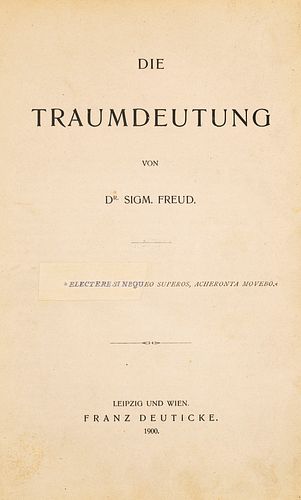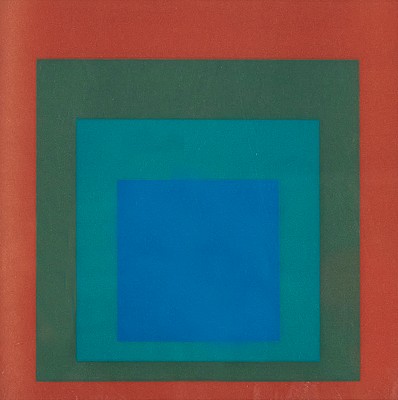Freud, Sigmund Die Traumdeutung. Leipzig und Wien, Franz Deuticke 1900 (1899). Titel, 1 Bl., 371 S., (1 S.), 2 Bl. Inhalts- und Literaturverzeichnis.
Lot 999
Absentee vs Live bid
Two ways to bid:
- Leave a max absentee bid and the platform will bid on your behalf up to your maximum bid during the live auction.
- Bid live during the auction and your bids will be submitted real-time to the auctioneer.
Bid Increments
| Price | Bid Increment |
|---|---|
| EUR€0 | EUR€10 |
| EUR€100 | EUR€10 |
| EUR€200 | EUR€20 |
| EUR€300 | EUR€30 |
| EUR€420 | EUR€30 |
| EUR€480 | EUR€20 |
| EUR€500 | EUR€50 |
| EUR€2,000 | EUR€200 |
| EUR€3,200 | EUR€300 |
About Auction
By Jeschke Jádi Auctions Berlin GmbH
Apr 29, 2022
Set Reminder
2022-04-29 07:00:00
2022-04-29 07:00:00
America/New_York
Bidsquare
Bidsquare : Rare Books, Prints, Classical Art (Auction 141)
https://www.bidsquare.com/auctions/jeschke-van-vliet/rare-books-prints-classical-art-auction-141-9237
Jeschke Jádi Auctions Berlin GmbH info@jvv-berlin.de
Jeschke Jádi Auctions Berlin GmbH info@jvv-berlin.de
- Lot Description
Medizin - Psychologie Freud, Sigmund Die Traumdeutung. Leipzig und Wien, Franz Deuticke 1900 (1899). Titel, 1 Bl., 371 S., (1 S.), 2 Bl. Inhalts- und Literaturverzeichnis. 8°. Handgebundener brauner Ziegenledereinband d. Zt. mit blindgeprägten Eckfleurons und goldgeprägten RTitel und schwarzgeprägter floraler Rückenornamentik. Signiert: Poszony. Vorsätze mit schönem Jugendstil-Buntpapier (minimal farbfleckig, berieben und beschabt). Garrison-Morton 4980. - Grinstein 277. - Printing and the Mind of Man 389. - Grolier/Medicine 87. - Norman F33. - Erste Ausgabe, mit dem Motto nach Virgil auf dem Titelblatt: "Flectere si nequeo superos, acheronta movebo" ("Wenn mich der Himmel nicht hört, dann ruf' ich die Hölle zur Hilfe"). Dieses bis Nequ handschriftlich im Stil der Type ergänzt und mit einem Blatt verstärkt, da das Papier dort eine kleinen Defekt hatte. Obwohl das Buch bereits am 4. November 1899 veröffentlicht wurde, datierte der Verleger das Titelblatt absichtlich ins 20. Jahrhundert. Das Werk erschien in einer Ausgabe von nur 600 Exemplaren, weil der Verleger besorgt war, dass der Aufsatz für ein breites Publikum nicht von Interesse sein könnte: tatsächlich wurde das Buch so schlecht verkauft, dass eine zweite Auflage erst 1909 nötig war. - Die "Traumdeutung" gilt als grundlegendes Werk der Psychoanalyse und enthält die zentralen Thesen und Themen der Freudschen Theorie (u.a. das Unbewusste, die Verdrängung, die frühkindlichen Sexualität, den Ödipuskomplex, die Libido, die Enthüllung verborgener Konflikte als therapeutischer Methode etc.). Die Traumdeutung sei die "Via regia (lat.: der Königsweg) zur Kenntnis des Unbewussten im Seelenleben", daher sammelte Freud eigene und fremde Träume und begann diese zu analysieren. Seiner Annahme nach äußern sich in unseren Träumen geheime, verdrängte Wünsche. - Diese Erstausgabe gilt als die letzte zuerst in Buchform publizierte wissenschaftliche Revolution (Cohen, "The scientific revolution"). - Bruno, The Tradition of Science, S. 167f.: "His book represents the first attempt at a serious scientific study of the phenomenon of dreams, and Freud always regarded it as his greatest effort. (...) It is somewhat fitting that the first year of the twentieth century should witness the publication of Freud's landmark work probing the human mind. Judged by its originality, impact, and influence, his work ranks as high as any in the history of science." - Letzten drei Blätter am Rand mit Papier verstärkt, wenige Seiten am Oberrand minimal bestoßen mit kleinem Randdefekt, einige saubere Marginalien am Rand, nur papierbedingt etwas gebräunt, insgesamt sehr gut erhaltenes Exemplar. Hand-bound brown goatskin binding d. Zt. with blind-stamped corner fleurons and gold-stamped Spine title and black-stamped floral spine ornamentation. Signed: Poszony. Endpapers with beautiful art nouveau colored paper. (minimally color stained, rubbed and scuffed). First edition, with the motto after Virgil on the title page: "Flectere si nequeo superos, acheronta movebo" ("If heaven does not hear me, then I call hell to help"). This to Nequ handwritten in the style of type supplemented and reinforced with a sheet, because the paper had a small defect there. Although the book was published as early as November 4, 1899, the publisher intentionally dated the title page to the 20th century. The work appeared in an edition of only 600 copies because the publisher was concerned that the essay would not be of interest to a wide audience: in fact, the book sold so poorly that a second edition was not necessary until 1909. - The "Interpretation of Dreams" is considered the foundational work of psychoanalysis and contains the central theses and themes of Freudian theory (including the unconscious, repression, early childhood sexuality, the Oedipus complex, the libido, the revelation of hidden conflicts as a therapeutic method, etc.). Dream interpretation was the "via regia (Latin: the royal road) to knowledge of the unconscious in the life of the soul," so Freud collected his own and other people's dreams and began to analyze them. According to his assumption, secret, repressed desires express themselves in our dreams. - This first edition is considered the last scientific revolution first published in book form (Cohen, "The scientific revolution"). - Bruno, The Tradition of Science, p. 167f.: "His book represents the first attempt at a serious scientific study of the phenomenon of dreams, and Freud always regarded it as his greatest effort. (...) It is somewhat fitting that the first year of the twentieth century should witness the publication of Freud's landmark work probing the human mind. Judged by its originality, impact, and influence, his work ranks as high as any in the history of science." - Last three leaves reinforced with paper at margins, a few pages minimally bumped at top edge with small marginal defect, a few neat marginalia at margins, only a little browned due to paper, overall a very good copy.
- Buyer's Premium



 EUR
EUR CAD
CAD AUD
AUD GBP
GBP MXN
MXN HKD
HKD CNY
CNY MYR
MYR SEK
SEK SGD
SGD CHF
CHF THB
THB






